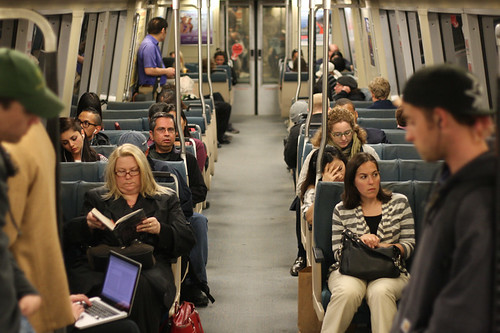
Horror stories of the things found on BART’s fabric-covered seats range from drug-resistant bacteria to the more mundane used condom or human feces.
With the launch of the so-called “Fleet of the Future” in 2017, however, the transit system is looking to replace those comfortable but hard-to-clean seats with more efficient ones that will provide more space to standing riders and prove easier to keep sanitary.
“We currently have the widest seats in the rail business at 23 inches,” said BART Board of Directors President Bob Franklin. “That doesn’t leave a lot of aisle width.”
SF State students will have the opportunity to comment on the new options today during a seating lab in the Cesar Chavez Student Center. The testing session will be open from 11 a.m. to 2 p.m. on the plaza level.
“We are looking at four different criteria,” Franklin said. “Height, width, legroom and material are all factors.”
BART spokesman Linton Johnson also noted that a variety of other things factor into the seat decision.
“The new cars will also have three doors on each side instead of two, so we will be reconfiguring the cars,” Johnson said.
He also said that though the current wide seats offer comfort, they limit the aisle space for standing.
“Even today, people are seeing that it’s difficult to get out when you get to your stop,” Johnson said.
According to Franklin, participants in the feedback session will fill out a form asking questions about each of the seat options.
Nine similar seating labs have already been or will be conducted throughout the summer, Johnson said.
BART seats became national news in March after SF State biology lab supervisor Darleen Franklin tested one seat and found fecal and skin-borne bacteria that is resistant to antibiotics.
Johnson said that while “cloth is more difficult to clean, it’s easier to keep up appearances. A vinyl seat can scratch.”
SF State creative writing senior Carissa Mendenhall said than she would prefer something easier to clean that the current seats.
“I know upholstery fabric absorbs moisture and bacteria and all that stuff,” Mendenhall said. “So I prefer like plastic seats like Muni. That way you can disinfect them easily.”
Kathleen Gilligan, a senior studio arts major, concurred with Mendenhall’s assessment.
“I think if they change the seats more or go with the plastic ones, it will be a little more clean,” Gilligan said.
According to Franklin, the overhaul project will cost $3.4 billion and new cars will begin being introduced in 2017, with older cars being rotated out with newer ones until the entire fleet has been replaced by an end goal date of 2024.
“Once we get all of this feedback, they will build a mock-up vehicle that can also be tested, so there will be plenty of opportunities for community feedback,” Franklin said.
The overhaul comes as BART anticipates a jump in ridership in the coming years.
“We currently have 350,000 to 375,000 riders,” Johnson said. “We’re looking at 500,000 in the future and our [current] train cars cannot carry the crowd of the future.”




